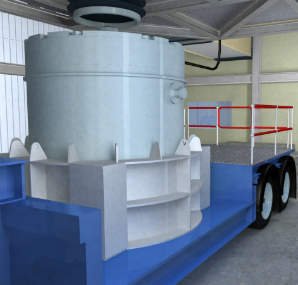Construction has begun at Sellafield on a new plant to use petrol pump technology to dispense contaminated sludge from the Windscale Pile Fuel Storage Pond into shielded waste drums.

Construction has begun at Sellafield on a new plant to use petrol pump technology to dispense contaminated sludge from the Windscale Pile Fuel Storage Pond into shielded waste drums.
The plant is being built by Nuvia and is expected to be commissioned in mid-2015.
Dorothy Gradden, Head of PFSP explained: "The pond was built in 1948 and contains more than 300 cubic metres of radioactive sludge, which is made up of fuel corrosion products and algae, which have been accumulating in this open air pond. It poses one of the most challenging decommissioning projects on the Sellafield site."
The pond is 100 metres long, 25 metres wide and 7 metres deep, containing over 15 million litres of water, more than 300m3 of sludge, various nuclear wastes and legacy spent nuclear fuel in metal skips in the pond.
A machine known as the sludge retrieval hood has been specially designed and built for the job of hoovering up sludge from the seven-metre-deep pond; sludge is also being removed from the open top fuel skips using a skip washing machine. The sludge is temporarily stored within an in-pond corral.
Radioactive sludge will be pumped from the PFSP corral to a Local Sludge Treatment Plant (LSTP) completed in 2012. This facility comprises an overbuilding containing four secondary containment cells. These contain a sludge thickening and sentencing module and three Buffer Storage Tanks (BSTs) together with their associated pump modules, sampling systems and control systems. Sludge is pumped in batches from the pond to the thickener vessel where it is allowed to settle. The thickened sludge — about the consistency of ketchup, according to Gradden — will then be transferred to one of the BSTs and the supernate from the settled sludge returned to the pond.
A peristaltic pump will transport sludge over a pipebridge to the new Drum Filling Plant.
Project Manager Chris Plane said: "We have designed a building skeleton containing what is effectively a large-scale petrol filling pump which we’ve proved using a test rig and it does what it says on the tin – it fills drums."
The drums will sit inside a 40 tonne transport flask on the back of a transport wagon which is already used on the site for moving waste between plants. The filling system is lowered onto the flask using locomotive lifts from the rail industry and the drum filled without ever leaving the flask. A new lid is being designed for the existing flask using 3D scanning technology to introduce a filling port to allow the sludge to be metered into the drum.
From the Drum Filling Plant, expected to cost £20 million, sludge waste will be driven to the Waste Encapsulation Plant. The original £70 million plan for the plant involved a nuclear crane, shielded concrete operating cells and reinforced foundations.
The plant will be built as separate modules to allow it to be assembled and tested off site in a controlled environment before being unplugged and shipped to site. Module build Following contract award on 1 May, the module build phase has begun. It will be followed by inactive commissioning (without radioactive materials), and modules will be brought to site early next year, with a view to starting active commissioning in mid-2015 and starting full operations shortly afterwards.
